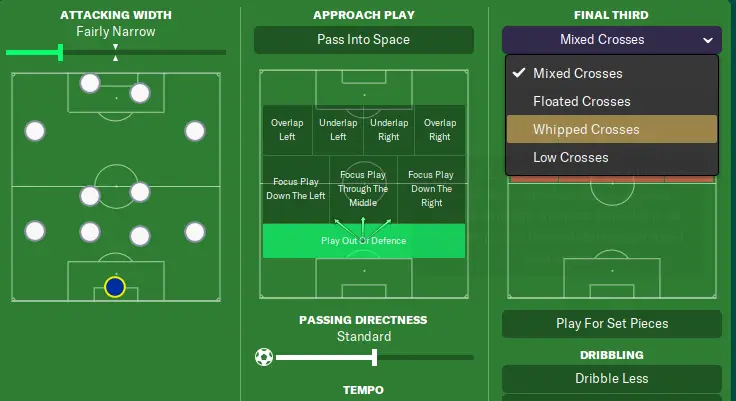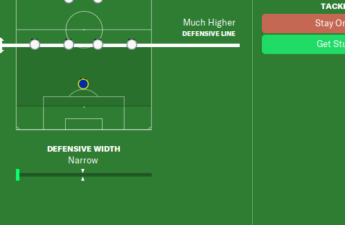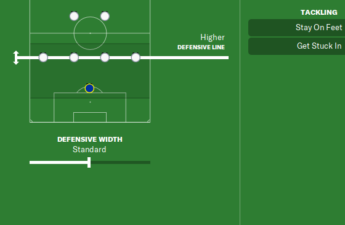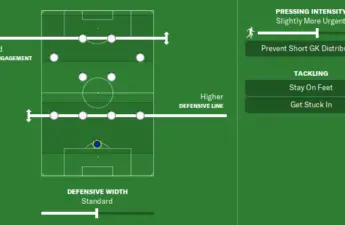Crosses in football manager, and also in real life, are an effective way of breaking down a stubborn defence when your “fancy” tiki taka brand of football with two enganches, a libero and a trequartista fails to bear fruits.
However, your winger continuously failing to deliver the perfect cross to your advanced forward or target man is bound to get frustrating after the third time he hits the ball straight to the opposition full back.
Therefore, deciding what kind of set up gives your wingers or fullbacks the best chance to deliver good crosses into the box, and what type of crosses they should try; whipped, floated, or low to give your strikers or midfield runners from deep the best chance of getting at the end of them is important.
Floated Crosses in FM
Floated crosses team instruction in football manager asks your players to get more height on the delivery into the penalty area with the intention of finding a player who has a height advantage over their marker or giving time for a player with good movement to find space for a free header.

This crossing instruction is suitable for slow, target men kind of players with high strength, good jumping reach and excellent heading.
It can successfully be used with a deep lying forward, a complete forward with suitable attributes and the target man.
Floating the ball into the box gives the strong player with a high jumping reach the opportunity to outjump everyone, and head the ball home.
However, if you have other players in your team making runs into the box, and they do not possess the same attributes as your big striker, their runs will mostly be fruitless as they will rarely win headers unless they benefit from rebounds or a knockdown from your striker.
You can slightly reduce this risk by asking your wingers to aim their crosses at your target man, from whom your other players can then benefit from his knockdowns.
This makes it a good idea, to use the floated crosses in a system that will rarely feature runners from deep, or one that has two capable strikers who can hold their ground and outjump most defenders in the league.
I personally do not floated crosses on players that have excellent movement, as I often find these kinds of players also have good acceleration and pace which make them good candidates for the whipped or low crosses instruction.
Whipped Crosses in FM
Whipped crosses in football manager ask your players to deliver balls into the box with pace, swerve and dip in order to make it as hard as possible for defenders to deal with them
Liverpool’s Trent Alexander Arnold is a master of delivering these kinds of balls into the box, which has led to relatively small-statured players like Diogo Jota and Sadio Mané in the past getting quite a few goals from crosses.
Diogo Jota in particular has scored numerous headed goals in the Premier League, rivalling the likes of Christian Benteke and Andy Carroll who are famed for their heading prowess, which is a testament to Jota’s excellent movement, heading ability and the whipped crosses from TAA that are difficult for the defence to deal with.
Therefore, you should ideally use whipped crosses against a defence that has packed the bus, making it difficult for your team to find a way through with other types of crosses.
Whipping the crosses in might make your forward players, who ideally should have excellent movement, get to the ball and head it home before the defenders can react.
Whipped crosses might also lead to the opposition defence making a mess of clearing the ball, giving a chance to your strikers to benefit from a botched clearance, and slot the ball home
Low Crosses in FM
Low crosses in football manager instruct players to deliver balls into the box closer to the ground.
FM explains that low crosses will largely benefit forwards that lack in size but are instead quicker off the mark and can lose their defender in a small area of space.
Raheem Sterling, previously plying his trade for Manchester City, benefitted from being nimble and quick-footed around the box, which led to him scoring countless goals from low crosses originating from the likes of Cancelo and Kevin de Bruyne.
A tiki-taka style of football that often comprises small-sized players with excellent technical ability will benefit from delivering low crosses in the box, as they will rarely enjoy success in the air unless they have a big no. 9
Low crosses shift the advantage to players that have good acceleration and movement, as they will time and time again get to the ball first before the opposition’s defence can react.
I personally couple low crosses with the added player instruction to deliver crosses to the near post, which I think yields the best result, as you do not expect the ball to cut across the 18-yard box to the far post while travelling close to the ground.
It is however important to understand that asking your players to deliver one type of cross will not mean they will not try the other types when they feel it is best to do so.
If your winger thinks whipping the cross to the far past area is the best decision to make rather than floating it to your target man at the centre of the box, he will make that decision.
If you have found this useful, consider taking a look at our articles covering high and low tempo, passing directness or time-wasting in football manager.


